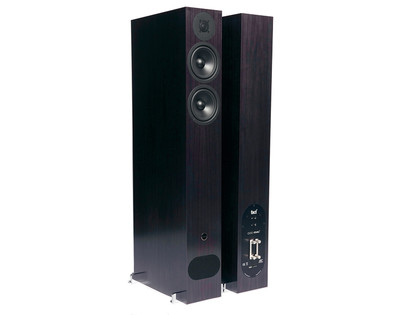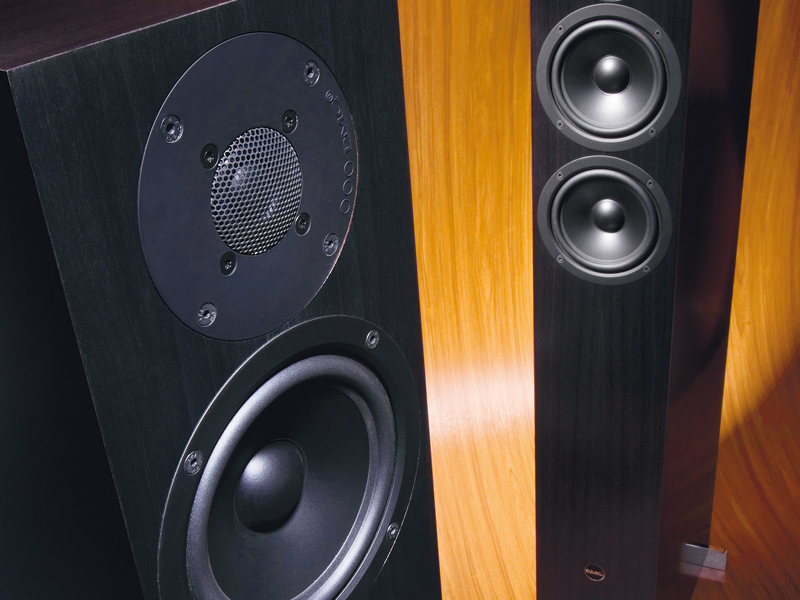TechRadar Verdict
The first of PMC's new generation models, fact.8 doesn't come cheap, but it does feature a beautiful styling and finish, alongside a lovely all-round sound quality with a notably wide dynamic range, good bass extension and negligible boxiness
Pros
- +
Slim and attractive
- +
Delivers a very fine, well balanced sound
- +
Superb imaging and low 'noise floor' offers notably wide dynamic range
Cons
- -
Bit pricey for compact two-way model
- -
Mid-forward character becomes a little aggressive at high levels
- -
Limited ultimate loudness
Why you can trust TechRadar
It's roughly 20 years since PMC – the initials abbreviate Professional Monitor Company – first appeared on the Hi-Fi speaker scene. Since then, the company has enjoyed consistent growth alongside a steadily enhanced reputation in both the Hi-Fi and studio monitoring fields, with an inexorably expanding range of models to suit all manner of listening environments and requirements, such as the new fact.8 loudspeaker.
Apart from obvious distinctions in surface finish, some are more clearly oriented towards home use and others towards the studio. Despite this, plenty of common ground has given the brand a solid and coherent identity that treads a well-judged line between performance and value for money.
Having created speakers that seem to satisfy both domestic and professional markets equally well, PMC has just introduced the £4,600 per pair fact.8, the first ever model that's primarily designed for and aimed at the upmarket Hi-Fi sector.
The distinction is clearly visible: in the super slim front view; in the luxury-quality, real-wood veneer and fashionably sharp-edged enclosure; in the classy spike-accommodating outriggers; in the attractive silver-plated terminals and links; in the hidden magnetic fastening for the grille; and in the little switches that can subtly shift tonal balance.
All these features have much more obvious appeal to the audiophile and domestic Hi-Fi communities than to professional users, and that's without examining any of them in detail, or indeed scrutinising any of the internal features of the speaker.
We'll get on to the hidden stuff in due course, but it would be a shame not to pay due attention to the fact.8's very classy presentation. The enclosure itself is beautifully built and veneered on all six faces in a choice of four rather unusual wood veneers.
Our samples came in a very subtle 'graphite poplar', giving a dark grey impression at a distance, while delicate grain and a slight deep reddish tinge are revealed close up. The option list includes 'rich walnut', 'natural oak' and 'tiger ebony'.
Sign up for breaking news, reviews, opinion, top tech deals, and more.
A full-height dark grey fabric grille fits flush against the front panel with no visible means of support: offer it up and magnets concealed under the veneer 'suck' it firmly into place.
The floor coupling is particularly neat. Two chrome-plated steel 'ingots' (each 230x35x9mm) are bolted edgewise into deep 9mm slots in the base of the speaker, adding mass and providing a solid platform for fixing the adjustable, reversible and chrome-plated spike/ball feet.
The net result is both stable and effective – but could have been significantly improved if proper locknuts had been supplied instead of the commonly seen little thumbwheel nuts that tend to work loose all too easily.
The twin terminal socket/binder pairs and optional connecting strips are all silver-plated, and are fixed through a substantial steel panel that accommodates the complex 24dB/octave internal crossover network.
Also on this panel are two tiny toggle switches, each of which allow selection between three settings for relative bass (0, -3dB, -6dB) and treble (0, -1dB, -2dB) level, allowing adjustment to suit speaker positioning, system and room characteristics and personal taste. These are claimed to operate without introducing any sonic compromise.

In order to achieve that super-slim front view, fact.8 uses two PMC-built main drivers, each relatively small (nominally 140mm) in diameter, with lightly doped 95mm diameter flared paper cones.
The tweeter, sourced from SEAS, is an unusual device. The basic dome is 19mm in diameter, but it has a wide surround that also contributes especially at the lower end of the tweeter's working range and has an outside diameter of 32mm. The perforated metal cover provides protection and is also claimed to enhance dispersion.
The bass loading is supplied by one of PMC's trademark ATL transmission lines – a well with the bass set 'flat', the treble at '-2dB', and the speakers positioned well clear of walls, the averaged in-room far-field response looks very well ordered. It holds within +/-6dB right across the audio band, and +/-4dB above 55hz. Sensitivity is a very respectable 89dB.
Sound quality
Auditioning was carried out in a heavily furnished and somewhat irregular 4.4x2.6x5.5m (WxhxD) room. The speakers were two metres apart with their backs 0.6 metres from the nearest wall.
Most of the listening was done using a Naim CDS 3/555PS CD player, a modified hybrid Rega/Linn Sondek LP12 with Rega RB1000 tonearm and Soundsmith Strain Gauge cartridge and a Magnum Dynalab MD 106T tuner.
Amplifiers included a Naim NAC552/NAP500 combo and an exceptional integrated valve amplifier called theLars.
Cables were from Chord Company, Vertex AQ, Phonosophie, and Naim, while equipment supports included Mana, Vertex AQ, Naim and Townshend types.
After installation, it took just a few seconds to appreciate that this loudspeaker is something really rather special, especially in view of its rather modest looking driver line-up. Its most obvious strength is a notable wide dynamic range, less because of the dynamic expression per se, which is more or less average, but rather because its background 'noise' or 'mush' floor is exceptionally low.
This is essentially a wide-dispersion design, so if the precision and focus of the stereo soundstage is slightly diluted, the fact.8s supply impressively convincing imaging across an unusually generous listening zone – much wider indeed than the separation of the speakers themselves.
They also go some way towards filling the end of the room with a spacious and airy soundstage, well detached from the speakers themselves, and assisted by a general freedom from any boxy effects.
The balance isn't entirely neutral, as the upper midband is a little 'forward', the more so because the upper bass and lower mid are just a shade shy. This tends to overemphasise detail slightly, which is arguably beneficial, but it can also add a touch of aggression when the volume is turned up high.
Given the speaker's size, the good bass extension and weight came as a bit of a surprise, though certainly a very welcome one. There's usually some compromise in any loudspeaker design and here the designer seems to have opted to supply full bass output at some expense to the maximum volume it puts out.
However, there's also the observation that because the speaker sounds so exceptionally clean and smooth, there is a tendency to wind up the volume and listen at a rather higher level than one might with a less capable speaker.
However, the fact.8 will still happily go loud enough to satisfy most domestic listeners in most rooms for nearly all of the time. Only those whose tastes extend to playing Slipknot or The Chemical Brothers persistently at the sort of levels guaranteed to irritate the neighbourhood might perhaps be better off looking elsewhere.

Criticisms are few and minor here – a high price, a slight mid-forwardness, limited ultimate loudness capability is about all. on the credit side, this is an excellent speaker: well balanced and unusually clean and clear sounding, with no discernible boxiness.
Yet it's also beautifully styled, presented and finished, which is arguably even more important in an increasingly crowded marketplace.
Follow TechRadar Reviews on Twitter: http://twitter.com/techradarreview
